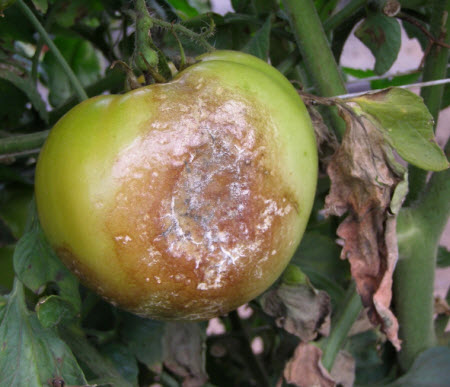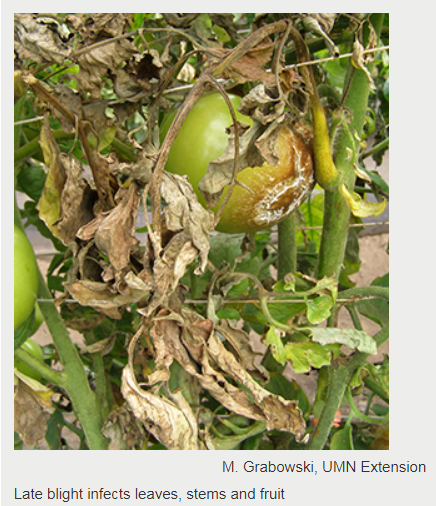Click below to listen to my 2 min. Garden Bite radio show: Controlling late blight on tomatoes
Audio Player
Ugh… late blight.
If you lost your homegrown tomatoes due to a nasty disease called Late Blight, will the disease affect this years crop? Not likely, the pathogen doesn’t survive our winter. It’s generally brought in from elsewhere. It can only survive on potato culls or tomato fruit that are sheltered in soil or a warm compost pile.

For now, our humidity has been low in spite of HOT weather. But we know that can change.
Late blight is caused by a water mold and needs high levels of moisture to thrive, so if we get a lot of rain, it could be a problem again.

What to do now:
- Pull any tomato and potato plants that came up on their own, those volunteers can harbor the pathogen.
- Inspect your purchases for signs. Leaves and stems should be green and firm.
- Avoid any plants with dark rotten areas. Buy plants that are disease resistant. Red Racer and Valentine, are resistant to other types of diseases…
- Provide plenty of space between your tomato plants and be sure to stake them, this allows for better air circulation, which means quicker drying and keeping them off the ground.
- Check plants for disease regularly.
Here is a diagnostic tool from the University of MN.
| Tomato varieties with resistance to late blight |
|---|
| Mountain Magic (F1) |
| Plum Regal (F1) |
| Defiant PhR (F1) |
| Mountain Merit (F1) |
| Iron Lady (F1) |
| Jasper (F1) |
| Red Pearl (F1) |
| Legend |
| Matt’s Wild Cherry |
| Wapsipinicon Peach |
| Lemon Drop |
| Pruden’s Purple |
As for potatoes, buy only from a reputable supplier.
Finally, if late blight shows up, infected plants should be buried to prevent movement of airborne spores. Some gardeners place the infected plant in a closed plastic bag and allow it to ‘cook’ in the sun for several days before burying in the compost or garden soil to make sure the pathogen is dead.
This link takes you to more tomato leaf spot diseases by the University of Minnesota Extension.
